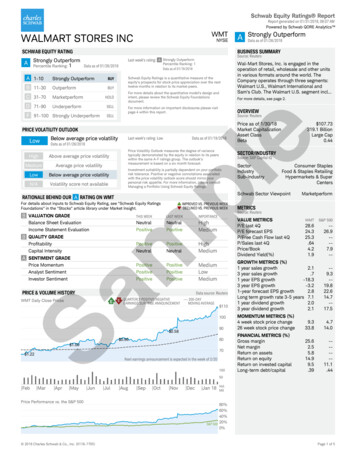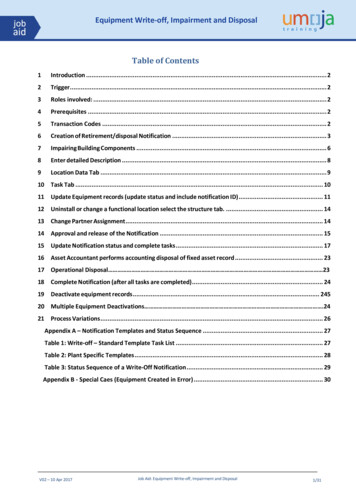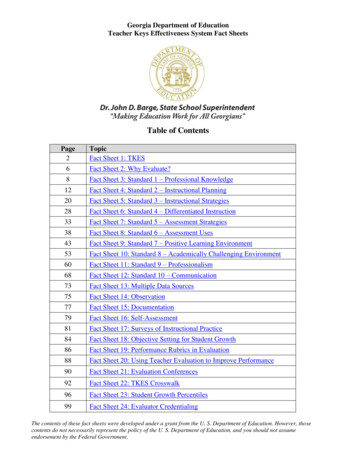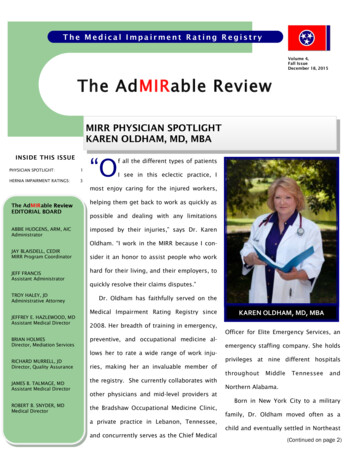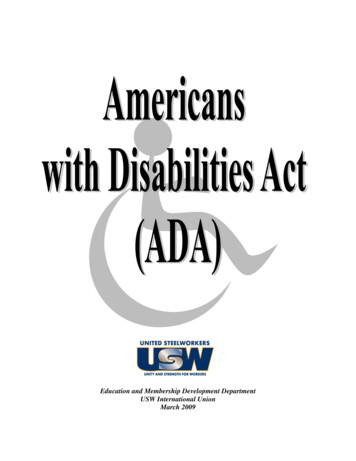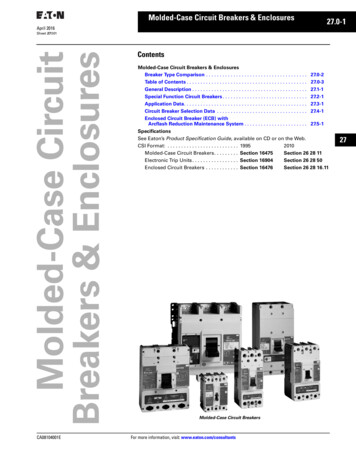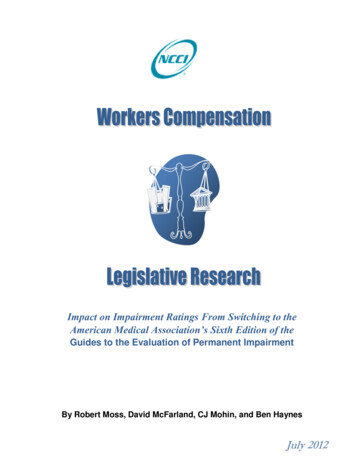
Transcription
Impact on Impairment Ratings From Switching to theAmerican Medical Association’s Sixth Edition of theGuides to the Evaluation of Permanent ImpairmentBy Robert Moss, David McFarland, CJ Mohin, and Ben HaynesJuly 2012
Impact on Impairment Ratings from theAmerican Medical Association’s Sixth Edition of theGuides to the Evaluation of Permanent ImpairmentTABLE OF CONTENTSBACKGROUND . 3AMA GUIDES—SIXTH EDITION . 4COMPARING AVERAGE IMPAIRMENT RATINGS—FIFTH EDITION VS. SIXTH EDITION . 5STATES EXAMINED: KENTUCKY, GEORGIA, MONTANA, TENNESSEE, AND NEW MEXICO . 5THE UNDERLYING DATA. 6RESULTS AND OBSERVATIONS . 7KENTUCKY . 7GEORGIA. 10MONTANA . 11TENNESSEE . 17NEW MEXICO . 21CONCLUSION. 25APPENDIX ATable 1—Distribution of Claims by Accident YearTable 2—Distribution of Claims by GenderTable 3—Distribution of Claims by AgeTable 4—Average Impairment Rating by Accident Year within MMI Year—MontanaTable 5—Average Impairment Rating by MMI Year within Accident Year—TennesseeTable 6—Average Impairment Rating by Accident Year within MMI Year—New MexicoAPPENDIX B—AMA Guides by StatePage 2 of 36
Impact on Impairment Ratings from theAmerican Medical Association’s Sixth Edition of theGuides to the Evaluation of Permanent ImpairmentBy Robert Moss, David McFarland, CJ Mohin, and Ben Haynes *AbstractRating the degree of permanent impairment has been a contentious process in manystate workers compensation systems. With the December 2007 release of the sixthedition of the American Medical Association’s Guides to the Evaluation of PermanentImpairment (AMA Guides), many stakeholders had concerns over the possibleimpact of this latest edition on claimant awards.NCCI provides some background on the AMA Guides and analyzes impacts onimpairment ratings due to the implementation of the sixth editionKey Findings: For the states studied, a decrease in the average impairment rating isobserved in the years immediately after the implementation of the sixth edition.BACKGROUNDThe approach to impairment evaluation has evolved over the past 50 years, starting in1958 with publication by the American Medical Association (AMA) of the article, ―AGuide to the Evaluation of Permanent Impairment of the Extremities and Back.‖ TheAMA Guides was first published in 1971, and new editions were published throughoutthe subsequent years with the sixth edition appearing in December 2007.1The AMA Guides to the Evaluation of Permanent Impairment is the most widely usedbasis for determining impairment ratings in state workers compensation systems. In1“Clarifications and Corrections—Sixth edition” was made available in 2008.*Robert Moss is an associate of the Casualty Actuarial Society (ACAS) and an associate actuary at the National Council onCompensation Insurance, Inc. (NCCI). David McFarland and Chenjun Mohin are actuarial analysts at NCCI. Ben Haynes wasformerly employed as a senior actuarial analyst at NCCI. We thank staff of the Montana Department of Labor and Industry,Employment Relations Division; Tennessee Department of Labor and Workforce Development, WC Division; and New MexicoWorkers’ Compensation Administration for their guidance and sharing of data. Finally, we acknowledge Raji Chadarevian,associate actuary and legislative research focus lead at NCCI for his assistance throughout the project.Page 3 of 36
Impact on Impairment Ratings from theAmerican Medical Association’s Sixth Edition of theGuides to the Evaluation of Permanent Impairmentaddition to workers compensation, they are used in federal systems, automobilecasualty, and personal injury cases.2Many states use the AMA Guides as a starting point in determining work disability,although statutes may differ as to which edition to use and how it is to be used. Thefollowing are some examples of how work disability may be determined: State-specific guidelines for certain diagnoses/injuries and use of the AMAGuides for othersUse of a statutory schedule for amputations, hearing loss, visual loss,hernias, and disfigurement and use of the AMA Guides for Nonscheduled injuries Determining the extent a scheduled member injury bears to its total lossSome states do not specify the use of any specific guidelines. Appendix B summarizesstate rules regarding which AMA Guides, if any, are currently in effect.AMA GUIDES—SIXTH EDITIONThe sixth edition of the AMA Guides, published in December 2007 (hereafter referred toas ―the sixth edition‖), introduced new approaches to rating impairment, including onebased on a modification of the conceptual framework of the International Classificationof Functioning, Disability, and Health (ICF). The ICF method is used as a common basisfor description of human function and impairments.According to its authors, the sixth edition was designed to provide rating percentagesthat consider (1) clinical and functional history, (2) examinations, and (3) clinical studiesto help physicians determine a grade within an assigned impairment class. The reasonfor this new approach was to determine an impairment rating that is both transparentand reproducible.Changes incorporated into the sixth edition include the following: 2Ratings that are largely diagnosis-based and diagnoses that are evidencebased when possibleStandardized assessment of Activities of Daily Living (ADL) limitationsassociated with physical impairmentsFunctional assessment tools to validate impairment rating scalesMeasures of functional loss in the impairment ratingImprovement in overall intrarater and interrater reliability and internalconsistencyFive ICF impairment classes from Class 0 (normal) to Class 4 (very severe)www.impairment.com/Use of AMA Guides.htm (referenced in December 2011)Page 4 of 36
Impact on Impairment Ratings from theAmerican Medical Association’s Sixth Edition of theGuides to the Evaluation of Permanent ImpairmentCOMPARING AVERAGE IMPAIRMENT RATINGS—FIFTH EDITION VS. SIXTHEDITIONIn this study, NCCI first looks at the change in the average impairment rating in statesthat did not switch editions. We then look at the change in the average impairmentrating for several states in the time period before and after the switch from the fifth tothe sixth edition. While we might consider simply looking at the change in the averageimpairment rating in states that switched editions to determine the impact of the switch,there are likely to be other factors impacting the average impairment ratings in thosestates. For example, it is expected that certain factors (e.g., variation in economicactivity) will affect the types of claims observed in certain years. As such, by observingthe changes in the average impairment ratings in states that did not switch editions, wecan consider the impact on impairment ratings due to factors unrelated to the switch ineditions.The focus of this study is on the impact of moving from the fifth edition to the sixthedition. The use of several years of experience allows for observing variability in theaverage impairment rating from one year to the next, both pre- and post-sixth edition.The use of several years of post-sixth edition experience also allows for the possibilitythat it may take more than one year to realize the full impact on ratings from a change ineditions.STATES EXAMINED: KENTUCKY, GEORGIA, MONTANA, TENNESSEE, AND NEW MEXICOIn NCCI’s analysis, Montana, Tennessee, and New Mexico were identified as statesthat switched from the fifth edition of the AMA Guides to the sixth edition with no majorchanges (i.e., legislative reforms) to the workers compensation system in the yearsimmediately prior or subsequent to the change in editions. The selection of a specificchange, such as a switch in AMA Guides, during a time of no other major changesallows for the determination of its impact on impairment ratings by isolating the effect ofthe change from other potential influences in the workers compensation system.To consider the impact on the average impairment ratings from other sources, welooked at the average impairment ratings in two different states, Georgia and Kentucky,which maintained the use of the fifth edition.Page 5 of 36
Impact on Impairment Ratings from theAmerican Medical Association’s Sixth Edition of theGuides to the Evaluation of Permanent ImpairmentTHE UNDERLYING DATAFor determining the impact on permanent partial impairment ratings based on a switchfrom the fifth edition to the sixth edition, claim records were supplied by the followingdata providers: Montana Department of Labor and Industry, Employment Relations DivisionNew Mexico Workers’ Compensation AdministrationTennessee Department of Labor and Workforce Development, WC DivisionKentucky Department of Workers’ ClaimsGeorgia State Board of Workers’ CompensationFor Montana, New Mexico, and Tennessee, NCCI requested claims level detail forpermanent partial disability (PPD) claims with injury dates or impairment ratingsbetween January 1, 2004 and December 31, 2009.3 The data fields that were requestedincluded: Date of InjuryImpairment and/or Disability RatingMaximum Medical Improvement (MMI) DatePart of BodyNature of InjuryPreinjury Weekly WageClass codeTotal Indemnity Benefits Paid by Injury Type (Temporary Total, PermanentPartial)GenderBirth YearClaim Status (Open, Closed, Other)Attorney Involvement IndicatorFor Kentucky, NCCI requested an update to data that had been provided previously fora research study on permanent partial disability claims. For Georgia, sufficient claimlevel data was available from claims data provided to NCCI for a previous researchstudy.In addition to validating the data, distributions of certain claim characteristics werereviewed to determine the reasonability and usability of the claims data. These criteriaincluded reviewing the distributions of claims by: GenderBody partNature of injuryIndustry group3Montana and New Mexico both base the impairment rating on the AMA edition in use on the date the rating ismade. Tennessee bases the rating on the edition in use on the date of injury.Page 6 of 36
Impact on Impairment Ratings from theAmerican Medical Association’s Sixth Edition of theGuides to the Evaluation of Permanent Impairment Preinjury wage amountsAgeBased on the observed distributions for all accident years examined, specifically withrespect to the relatively stable distributions based on gender, age, and number of claimsby accident year, the data for each state was determined to be suitable for this analysis.The individual state analyses were not adjusted for changes in the distributional mix byaccident year. Please see Appendix A for distributions of several of these claimcharacteristics by state.For all states in this analysis, the average impairment ratings were calculated by takingan average of nonzero impairment ratings.4RESULTS AND OBSERVATIONSBefore we can evaluate the impact of a change in the average impairment rating due toswitching from the fifth edition to the sixth edition, we must consider what changes mayhave occurred during this same time period from other sources. To consider this, welooked at the average impairment ratings in two different states, Georgia and Kentucky,which maintained use of the fifth edition.KENTUCKYClaims data was provided by the Kentucky Department of Workers’ Claims. The claimsrecords comprised 15,633 permanent partial disability (PPD) lost-time claims5 with injurydates between (and inclusive of) January 1, 2005 and December 31, 2008, evaluatedas of April 2012. The detailed claim records represented a rich collection of dataelements, including claim characteristics such as age, gender, preinjury weekly wage,injury date, part of body, and nature of injury.4Claims where the impairment rating field was blank were removed from the data set during the validationprocess.5Validation of the data set was performed in order to remove claims with questionable or invalid data; claimswere excluded where the impairment rating field was blank.Page 7 of 36
Impact on Impairment Ratings from theAmerican Medical Association’s Sixth Edition of theGuides to the Evaluation of Permanent ImpairmentOne key data element that was not available in the Kentucky data was maximummedical improvement (MMI) date.6 MMI date is used in our analysis of other states tocompare claims at common maturity levels. Because this data element was notavailable in the Kentucky data, the results shown in Table 1 do not control for claimmaturity.TABLE 1 [KENTUCKY]:AccidentYear# of PPDClaimsAverageRating*Percent Changein Avg. 67.5%0.2%20083,7167.1%–5.3%* As a percentage of whole personThe claims underlying Table 1 are for Accident Years 2005–2008, evaluated as of April2012. Since we were unable to control for claim maturity, the distribution of claims forAccident Year 2005 is not the same as that for Accident Year 2008. For example, aclaim from Accident Year 2005 may have received an impairment rating in 2009 (i.e.,four years later), whereas a claim of a similar nature from Accident Year 2008 may nothave been evaluated as of the date the data was provided in early 2012. The figuresabove may, therefore, not offer an equivalent comparison of claims and ratings acrossall accident years.However, given the volume of claims underlying Table 1, as well as the likelihood thatany additional claims would not have a material impact on the average ratings byaccident year, the moderately lower average impairment rating for Accident Year 2008does indicate a change in the average impairment rating compared to Accident Year2007.6MMI date is generally defined as the date after which further recovery from or lasting improvement to an injurycan no longer be reasonably anticipated based upon reasonable medical probability as determined by a healthcare provider.Page 8 of 36
Impact on Impairment Ratings from theAmerican Medical Association’s Sixth Edition of theGuides to the Evaluation of Permanent ImpairmentNCCI considered that this change may have resulted in some part from the structuralchanges in the economy due to the recession during this time; the percentage of claimsfrom certain industries, as shown in Table 2 below, suggests little change in theproportion of claims represented by these groups over this time period. Specificoccupations were selected based on their description and likelihood of being affected bythe 2007 recession.TABLE 2 [KENTUCKY]:Laborers Except Construction7Construction LaborersAccidentYear# ofClaims% ofTotalClaimsAverageRatingPercentChange inAvg. Rating# ofClaims% ofTotalClaimsAverageRatingPercentChange inAvg. %–15.7%2788.1%7.6% 1.8%2007792.2%9.3% %6.9%–2.5%Given the relatively small volume of claims for both groups, there is some expectedvariability in the average impairment ratings over the observed time period. However,note that the decrease in the average impairment ratings from 2007 to 2008 for both ofthese groups is similar to the change in the average impairment for all claims (see Table1). Table 3 compares the results for all other occupations.TABLE 3 [KENTUCKY]:All Other Occupations(Excluding Construction Laborers and Laborers Except Construction)Accident Year# of Claims% of TotalClaimsAverage RatingPercent Change inAverage 20073,25588.9%7.5% 0.3%20082,97989.4%7.2%-4.4%Note that the percentage of claims for all other occupations represents approximately90% of claims for each year, indicating little to no impact on the distribution of claims7“Construction Laborers” and “Laborers Except Construction” were judgmentally selected as occupations that mayhave been impacted by the recent recession. Detailed class code information was not included with which to morespecifically identify type of work involved.Page 9 of 36
Impact on Impairment Ratings from theAmerican Medical Association’s Sixth Edition of theGuides to the Evaluation of Permanent Impairmentfrom the 2007 recession. We recognize, however, that there may be a lag with respectto the impact of the recession on the claim distribution by occupation, with AccidentYear 2008 not fully reflecting recession-related changes in the industrial structure inKentucky.Nevertheless, the decrease in the average impairment rating from 2007 to 2008 inKentucky does not appear to be due to structural changes in the workforce from therecession that began in late 2007.GEORGIAGeorgia also has continued using the fifth edition of the AMA Guides when evaluatingimpairment. The claims records for Georgia, which were provided to NCCI by theGeorgia State Board of Workers’ Compensation for an unrelated research project,comprised 9,559 permanent partial disability (PPD) lost-time claims with injury datesbetween (and inclusive of) January 1, 2006 and December 31, 2008, evaluated as ofNovember 2009. The claim records included claim characteristics such as preinjuryweekly wage, injury date, part of body, and nature of injury.While Kentucky bases all impairment ratings as a percentage of whole body, Georgiaimpairment ratings can be determined either as a percentage of whole body or part ofbody. For example, a back injury may result in a 50% whole body impairment while apartial finger amputation may result in a 50% part of body (i.e., finger) impairment. Whileboth injuries have the same impairment percentage, the injuries and impairment basesare quite different and are, therefore, viewed separately for purposes of our analysis.The results from Georgia also show a change in the average impairment rating fromAccident Year 2007 to 2008:TABLE 4 [GEORGIA]:Whole Body8All OthersAccidentYear# ofClaimsAverageRatingPercentChange# 86607.2%–12.7%2,11110.0%–6.0%As was the case with Kentucky, the data underlying Table 4 was a snapshot taken at aparticular point in time. As such, impairment ratings for claims from each accident yearhave not been evaluated at the same relative time frame after the accident date.8Includes claims with injuries to multiple body systems, lower back, and whole body.Page 10 of 36
Impact on Impairment Ratings from theAmerican Medical Association’s Sixth Edition of theGuides to the Evaluation of Permanent ImpairmentAdditionally, the number of claims for Accident Year 2008 is much lower than 2006 and2007, due to the relative lack of maturity of Accident Year 2008 at the time the data wasreceived. As such, the average impairment ratings for Accident Year 2008 would likelybe impacted to a greater degree (compared to 2006 and 2007) when observed at a laterevaluation. However, initial results do suggest a decrease in the average impairmentrating over this time period, particularly for those ratings based on the whole body.While the impact and direction of the changes in Kentucky and Georgia are worthnoting, the mere presence of a change itself is an indication of the impact on theaverage impairment ratings from factors unrelated to which edition of the AMA Guideswas used to determine impairment. As such, when we observe the changes in theaverage impairment ratings in states that switched editions, we must also consider theimpact on the average impairment ratings from factors unrelated to the change ineditions.MONTANAMontana switched from the fifth edition of the AMA Guides to the sixth edition whenevaluating impairment, as dictated by statute. According to Montana’s statutes, theedition of the AMA Guides that is used to evaluate impairment is that edition which is ineffect when the impairment rating is made.9 It is also worth noting that the impairmentrating percentage in Montana is based on the part of the body that is impaired, which isthen translated to a percentage of the whole body.Claims data was provided by the Montana Department of Labor and Industry. Theclaims records comprised 2,780 permanent partial disability (PPD) lost-time claims10with maximum medical improvement (MMI) dates between (and inclusive of) January 1,2004 and December 31, 2009, evaluated as of June 2011. The detailed claim recordsrepresented a rich collection of data elements, including claim characteristics such asage, gender, preinjury weekly wage, accident date, part of body, and nature of injury.Since a claim for a particular accident year can be reported and/or evaluated manyyears after the accident date, and claims for an MMI year can include claims from amultitude of accident years, we group claims by corresponding accident year maturitieswithin each MMI year so that the claims being compared are similar in maturity. Forexample, we observe claims from Accident Years 2004, 2005, and 2006 where MMIwas achieved in 2006; Accident Years 2005, 2006, and 2007 where MMI was achievedin 2007; and so on for MMI years 2008 and 2009.9Since rating date was not available, the date of maximum medical improvement (MMI) was used since it wasassumed that the rating would soon follow a determination of MMI. Some sensitivity testing was performed incase actual ratings took place more than three months after MMI, but no material changes in impairment ratingswere observed.10Validation of the data set was performed in order to remove claims with questionable or invalid data; claimswere excluded where the impairment rating field was blank.Page 11 of 36
Impact on Impairment Ratings from theAmerican Medical Association’s Sixth Edition of theGuides to the Evaluation of Permanent ImpairmentBased on this criteria, there is a noteworthy decrease in the average impairment ratingof approximately 28%11 when comparing the average rating for MMI years 2006 and2007 (fifth edition) to the average rating for MMI years 2008 and 2009 (sixth edition) asshown in Table 5.TABLE 5 [MONTANA]:Fifth EditionSixth EditionMMI Year 2006MMI Year 2007MMI Year 2008MMI Year AverageImpairment Rating7.1%7.0%5.0%5.1%# of Claims306359404589Note that the ratings for MMI Year 2006 and 2007 are based on the fifth edition, bystatute, whereas the 2008 and 2009 ratings are based on the sixth edition.For a more detailed breakdown of average impairment ratings by accident year withineach MMI year, see Table 4 in Appendix A.The number of claims by MMI year grows over the four MMI years shown in Table 5,with a noteworthy increase from 2008 to 2009. This was due to an initiative undertakenby the Montana Department of Labor and Industry in July 2009 to improve compliancefor reporting of impairment ratings and MMI date.Additionally, when we observe the average impairment rating for all accident years byMMI year, as shown in Table 6 below, we observe a similar change in the averageimpairment ratings.11–28% [(5.0 * 404 5.1 * 589) / (404 589) / (7.1 * 306 7.0 * 359) / (306 359)] – 1Page 12 of 36
Impact on Impairment Ratings from theAmerican Medical Association’s Sixth Edition of theGuides to the Evaluation of Permanent ImpairmentTABLE 6 [MONTANA]:All Accident YearsFifth EditionSixth EditionMMI Year 2006MMI Year 2007MMI Year 2008MMI Year 2009Average Rating7.7%7.5%5.6%5.5%Total PPD Claims358408481698The results from Table 6 indicate a decrease in the average impairment rating of 27%12over this time period. As a result, the average impairment rating for Montana appears tohave declined from the years just preceding the change to the years subsequent to thechange in editions.In order to help understand the possible impact on the average impairment rating due tofactors unrelated to the switch in editions, we reviewed year-to-year changes in theaverage impairment ratings under the fifth edition. As we see in Table 7, the year-toyear variability in the average rating is relatively small under the fifth edition. Thissuggests that the drop in the average rating between MMI years 2007 and 2008resulted primarily from the switch in editions.TABLE 7 [MONTANA]:Average Impairment Rating—Fifth EditionMMI Year 2004AYs 2003–2004MMI Year 2005AYs 2004–2005MMI Year 2006AYs 2005–2006MMI Year 2007AYs 2006–20076.5%7.0%6.7%6.6%The rating system in Montana, which modifies impairment ratings in certain cases toarrive at a final disability rating, also allows us to observe how wage replacementbenefits may be impacted by legislative changes that affect underlying impairmentratings for PPD claims.Disability modification factors adjust an impairment rating for individual claimantcharacteristics such as age, education, wage loss, and physical ability. These factorsmay also be impacted by a switch in editions, resulting in final disability ratings that areinfluenced by changes in the underlying impairment ratings. Any influence on disabilityratings would affect the potential impact on overall system costs from a change in AMAeditions in states where a disability rating is the basis for benefits compared to thosewhere impairment ratings are used without modification.1227% [(5.6 * 481 5.5 * 698) / (481 698) / (7.7 * 358 7.5 * 408) / (358 408)] – 1Page 13 of 36
Impact on Impairment Ratings from theAmerican Medical Association’s Sixth Edition of theGuides to the Evaluation of Permanent ImpairmentTo determine the final disability rating in Montana, the sum of the modification factors isadded to the impairment rating. To the extent that there is an attempt by claimants topursue a higher modification factor to counteract a decrease in their impairment rating,we may observe higher disability modifications for MMI years 2008 and 2009 comparedto 2006 and 2007. The values in Table 8 show the average disability modification factorfor MMI years 2006 through 2009 (for those claims with modification factors):TABLE 8 [MONTANA]:Average Disability Modification FactorFifth EditionSixth EditionMMI Year 2006MMI Year 2007MMI Year 2008MMI Year 2009Accident YearsAccident YearsAccident YearsAccident 9.719.920.721.7These values do suggest a small increase in the average disability modifications inMontana over the observed time period. While the switch to the sixth edition may havehad an impact on the disability modification factors, the inclusion of wage loss in thedisability rating formula along with higher amounts of wage loss from the recentrecession may also be contributing to the higher disability mods for MMI years 2008 and2009.Note that not all claims receive a disability modification, thereby resulting in fewerclaims available with which to evaluate changes to the average modification factor.The switch in editions appears to have had a more noteworthy impact on certain typesof injuries compared to others. The results from Montana in Table 9 below show adecrease in the average impairment rating for shoulder and lower back injuries.TABLE 9 [MONTANA]:Average Impairment RatingFifth EditionPart of BodyShoulderKneeLower BackMMI Year 2006AYs 2004–20066.1%4.0%10.5%MMI Year 2007AYs 2005–20075.7%3.5%10.1%Page 14 of 36Sixth EditionMMI Year 2008AYs 2006–20085.0%3.5%5.8%MMI Year 2009AYs 2007–20094.6%3.8%7.0%
Impact on Impairment Ratings from theAmerican Medical Association’s Sixth Edition of theGuides to the Evaluation of Permanent ImpairmentThe change in ratings for low back injuries is also supported by Table 10, which indicatea significant change in the average impairment ratings for claims where strain is thenature of injury.TABLE 10 [MONTANA]:Average Impairment RatingFifth EditionNature ofInjuryContusionFractureSprainStrainSixth EditionMMI Year 2006AYs 2004–2006MMI Year 2007AYs 2005–2007MMI Year 2008AYs 2006–2008MMI Year 2009AYs %5.2%4.8%4.5%6.0%6.2%4.3%The differences in the average impairment ratings for fractures and sprains do not allowus to form any definitive conclusions regarding the impact from the sixth edition onthose types of injuries. However, there do appear to be significant declines in theaverage impairment ratings for contusions and strains (which represent approximately6% and 38% of PPD claims, respectively, for this time frame).Page 15 of 36
Impact on Impairment Ratings from theAmerican Medical Association’s Sixth Edition of theGuides to the Evaluation of Permanent ImpairmentWith respect to possible changes in the average impairment rating due to changes inthe mix of claims and/or injuries from the recession, the information in Table 11 showsthe average impairment rating and number of claims by NCCI industry group by MMIyear:TABLE 11 [MONTANA]:Fifth EditionMMI Year 2006
Impact on Impairment Ratings from the American Medical Association's Sixth Edition of the Guides to the Evaluation of Permanent Impairment Page 4 of 36 addition to workers compensation, they are used in federal systems, automobile casualty, and personal injury cases.2 Many states use the AMA Guides as a starting point in determining work disability,
